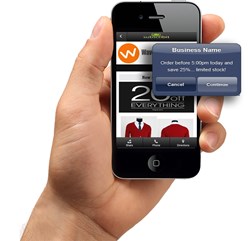Actual PULL BASED vs PUSH BASED Web Desing?
Some transformation is taking place in web designs. The way we navigate on websites is currently known as the « PULL-BASED ». It implies that we are going to the sites, we seek information and we download what we like.
A new trend is at our doors, this is the « PUSH-BASED », where the content and information will come to us instead of having to look for it.

The tendency to « PUSH BASED » began with Facebook that allows us to see what is going on in the lives of people without asking them and is now continuing with specific applications or routines like the « PUSH NOTIFICATION ».
PUSH NOTIFICATIONS
PUSH notifications are in our lives since the IPhone. Everyone knows them. Small windows opens to inform us about new software update, a phone call missed, a SMS received.
The scope is no longer limited to the applications and on mobile devices. Now, PUSH NOTIFICATIONS may appear on desktop computers, such as Google has integrated it in Chrome, versions 42 and later.
The websites are now able to communicate with visitors during and after their visit. Obviously you need to give permission for notifications from your favorite websites, which opens a small window on the screen to ask for permission to provide you with these notifications.
The future of web sites, only applications?
We do not believe that the future of websites will transform them all in applications to download. The old PULL BASED WEBSITE will always have its place, even if he looses it’s featured place.
Although PUSH BASED has many benefits, the marketing process cannot be in only one direction. Effective communication involves two entities, the transmitter and the receiver. Furthermore, establishing in advance all customer expectations is a risk, faultly targeting the audience in this concept, will cause a big defeat.

What is PULL and what is PUSH?
PUSH:
– Paying for ads on television, radio or printed distribution. You call a list of potential customers by phone. You post a discount coupon.
PULL:
– A blog, a free e-book about your expertise, marketing on social networks. A customer writes you an e-mail to inquire about your products. The client calls you because he saw your website.
These two forms of marketing, must coexist in order to maximize the potential of your products and services without forgetting the fundamental differences of each individuals. We are not all the same and we do not react the same way in the face of commercial solicitation, advertising, promotions or discounts.
PULL BASED vs PUSH BASED
The aim sought by the PULL is to intrigue consumers and present the information to motivate their actions.
In the notion of PUSH, identify the needs of future users and present them all the services in a mechanism.
Analysis of visitors and their habits is essential to make the PUSH BASED MARKETING. Apps are not mandatory. Notifications are sufficient to inform the user and the traditional website, even if he slows a bit, will always have its place.
Does the PUSH notion is fully developed?
No, not currently. Take for example PUSH notifications. They are only available on Chrome and Safari mostly. There is a small war to determine who will be the leader. The War between BETA and VHS resumes what’s happening now for the Push notifications on the market.
The leader will have to offer to all webmasters an API (A programming routine with a server) that will interact with all mobile devices on the market and desktop computers to satisfy wveryone.
Within a year, the PUSH concept will be a well-established notion in our opinion. For the moment, there are some APIs at Apple, Google and lots of extensions available to start on this path and become familiar with this trend.
Good and bad sides of PUSH NOTIFICATIONS
PUSH NOTIFICATIONS should be used with caution. Much like the POP-UP window who is in our lives for so long, if improperly used, it is a source of extreme frustration and users will do anything to get rid of it.
After trying the Google API, we decided here at Internet Cloud Canada not to proceed with PUSH NOTIFICATIONS on our website. We found « annoying » the fact to show a window in the corner of the browser asking for permission. We put ourselves in the place of our customers and have concluded that this type of « marketing » does not satisfy us.
By cons, we are actively working on a mobile application for our customers to offer them the choice of having notifications, news and access their client area via a mobile application. Currently our site is perfectly made for mobile browsing; It will be an addition of services in a very short time!
Every business must evaluates the actual need to put forward the PUSH NOTIFICATIONS. Note that there are certain prerequisites to be able to send notifications via the web, like:
– Your site must be on the HTTPS (in full). So if you have a blog, it will have be under a security certificate to distribute notifications. Google Chrome requires it and Apple too.
BEWARE !
It is possible that third-party providers allow you to use push notifications via their server over HTTPS, allowing you to dodge the need to have a security certificate.
Important! Third-party vendors will certainly establish their own advertising in your notifications and most importantly, they will capture information from your users to reinforce the databases on the habits of visitors.
If you plan to put in place such a solution, it is best to have its own security certificate on its website and set notifications with Google for now or wait an OPEN SOURCE solution that will keep the whole process of notifications on your own server. Your users will surely be pleased that you take care to preserve intact their privacy!

Vous devez vous connecter pour publier un commentaire.